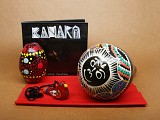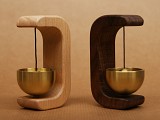500 Gr from Nepal (SKU 4533)
Our traditional hand beaten singing bowls are produced from a mix of metals and come complete with a turned wood Puja stick. Please note diameter, weight and thickness of the bowls will vary as this is a handmade product. Hand beaten bowls have a more complex and rich range of sounds than machine made bowls, but there is more of a knack to playing them!
Diameter approximately 13 cm. Min. weight: 451 gr. Max. weight: 550 gr. Origin: Nepal
Singing Bowls – Tradition, Craft, and Sound
Singing bowls are a type of standing bell that produce resonant, sustained tones when struck or played around the rim with a wooden striker. Their sound, at once grounding and expansive, has been used for centuries across Asia to support meditation, prayer, healing, and ritual. Today, they are also valued in sound therapy, Yoga practices, and even contemporary music for their rich tonal layers.
Historically, singing bowls have appeared across Nepal, Tibet, India, China, Vietnam, Japan, and Korea. Their origins are linked to both early Buddhist practices and ancient metalworking traditions. Some trace the earliest bowls to the Bon religion of Tibet; others suggest metal artisans in Assam, India, as early makers. The Silk Road helped carry these bowls across cultures, blending spiritual, ceremonial, and practical uses.
Traditionally, high-quality singing bowls are hand-forged from bell metal, a bronze alloy of approximately 80% copper and 20% tin. This composition gives the bowls their strong, sonorous tone. While stories of bowls made from seven sacred metals persist, most quality bowls are crafted from simple, time-tested materials. In the end, it is the time, skill, and generations of experience behind each bowl, not myths about exotic metals, that create a bowl’s true voice.
How to Play
Playing a singing bowl is simple but deeply rewarding: Rest the bowl on the open palm of your hand (or balance smaller bowls on your fingertips). Hold the striker vertically, with your fingertips pointing downward. Gently tap the striker against the side of the bowl to "warm up" the sound. Then, using steady, even pressure, rub the striker slowly, clockwise around the outer rim. Use a full-arm movement, much like stirring a large pot of soup. Keep the striker straight and firm against the bowl’s edge, allowing the tone to build gradually as the bowl vibrates.
Patience and light touch are key. As the sound grows, it invites natural focus and presence—whether for meditation, ceremony, or simple enjoyment.









